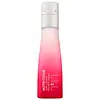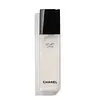What's inside
What's inside
 Key Ingredients
Key Ingredients

 Benefits
Benefits

 Concerns
Concerns

 Ingredients Side-by-side
Ingredients Side-by-side

Water
Skin ConditioningCoco-Caprylate/Caprate
EmollientPropylene Glycol Dicaprylate/Dicaprate
EmollientPropanediol
SolventGlycerin
HumectantNiacinamide
SmoothingPolyglyceryl-3 Methylglucose Distearate
EmulsifyingButylene Glycol
HumectantLaminaria Saccharina Extract
Skin ProtectingPorphyridium Cruentum Extract
Skin ConditioningLactobacillus Ferment
Skin ConditioningHydrolyzed Rice Extract
Skin ConditioningPunica Granatum Extract
AstringentZinc PCA
HumectantDipotassium Glycyrrhizate
HumectantCamellia Sinensis Leaf Extract
AntimicrobialSodium Hyaluronate
HumectantCaffeine
Skin ConditioningNarcissus Tazetta Bulb Extract
AstringentCucumis Sativus Fruit Extract
EmollientHelianthus Annuus Seed Extract
Skin ConditioningHordeum Vulgare Extract
EmollientSucrose
HumectantTocopheryl Acetate
AntioxidantSodium Phytate
Citric Acid
BufferingPropylene Glycol Dicaprate
EmollientCaprylyl Glycol
EmollientDicaprylyl Carbonate
EmollientHexylene Glycol
EmulsifyingHydrogenated Lecithin
EmulsifyingPotassium Cetyl Phosphate
EmulsifyingGlyceryl Stearate
EmollientSodium Hydroxide
BufferingSodium Benzoate
MaskingAcrylates/C10-30 Alkyl Acrylate Crosspolymer
Emulsion StabilisingAmmonium Acryloyldimethyltaurate/Vp Copolymer
Phenoxyethanol
PreservativeWater, Coco-Caprylate/Caprate, Propylene Glycol Dicaprylate/Dicaprate, Propanediol, Glycerin, Niacinamide, Polyglyceryl-3 Methylglucose Distearate, Butylene Glycol, Laminaria Saccharina Extract, Porphyridium Cruentum Extract, Lactobacillus Ferment, Hydrolyzed Rice Extract, Punica Granatum Extract, Zinc PCA, Dipotassium Glycyrrhizate, Camellia Sinensis Leaf Extract, Sodium Hyaluronate, Caffeine, Narcissus Tazetta Bulb Extract, Cucumis Sativus Fruit Extract, Helianthus Annuus Seed Extract, Hordeum Vulgare Extract, Sucrose, Tocopheryl Acetate, Sodium Phytate, Citric Acid, Propylene Glycol Dicaprate, Caprylyl Glycol, Dicaprylyl Carbonate, Hexylene Glycol, Hydrogenated Lecithin, Potassium Cetyl Phosphate, Glyceryl Stearate, Sodium Hydroxide, Sodium Benzoate, Acrylates/C10-30 Alkyl Acrylate Crosspolymer, Ammonium Acryloyldimethyltaurate/Vp Copolymer, Phenoxyethanol
Water
Skin ConditioningButylene Glycol
HumectantAlcohol
AntimicrobialDipropylene Glycol
HumectantGlycerin
HumectantPentylene Glycol
Skin ConditioningMethyl Gluceth-10
EmulsifyingIpomoea Batatas Root Extract
Skin ConditioningPPG-6-Decyltetradeceth-30
EmulsifyingPhenoxyethanol
PreservativeCaprylyl Glycol
EmollientPhytosteryl/Octyldodecyl Lauroyl Glutamate
Skin ConditioningSodium Citrate
BufferingXanthan Gum
EmulsifyingParfum
MaskingPolyquaternium-51
Skin ConditioningAmmonium Acryloyldimethyltaurate/Vp Copolymer
Alcaligenes Polysaccharides
EmollientSodium Hyaluronate
HumectantPhytic Acid
Citric Acid
BufferingHydrogenated Lecithin
EmulsifyingPolyglyceryl-10 Laurate
Skin ConditioningPolianthes Tuberosa Polysaccharide
Skin ConditioningSphingomonas Ferment Extract
Skin ConditioningHydrochloric Acid
BufferingSodium Benzoate
MaskingTocopherol
AntioxidantWater, Butylene Glycol, Alcohol, Dipropylene Glycol, Glycerin, Pentylene Glycol, Methyl Gluceth-10, Ipomoea Batatas Root Extract, PPG-6-Decyltetradeceth-30, Phenoxyethanol, Caprylyl Glycol, Phytosteryl/Octyldodecyl Lauroyl Glutamate, Sodium Citrate, Xanthan Gum, Parfum, Polyquaternium-51, Ammonium Acryloyldimethyltaurate/Vp Copolymer, Alcaligenes Polysaccharides, Sodium Hyaluronate, Phytic Acid, Citric Acid, Hydrogenated Lecithin, Polyglyceryl-10 Laurate, Polianthes Tuberosa Polysaccharide, Sphingomonas Ferment Extract, Hydrochloric Acid, Sodium Benzoate, Tocopherol
Ingredients Explained
These ingredients are found in both products.
Ingredients higher up in an ingredient list are typically present in a larger amount.
Ammonium Acryloyldimethyltaurate/Vp Copolymer (let's call it AAVC for short) is a synthetically created polymer. It's used as a film-forming agent and used to thicken the consistency of products.
AAVC is able to increase the consistency and viscosity of products due to its large molecule size. It also prevents ingredients from separating.
Butylene Glycol (or BG) is used within cosmetic products for a few different reasons:
Overall, Butylene Glycol is a safe and well-rounded ingredient that works well with other ingredients.
Though this ingredient works well with most skin types, some people with sensitive skin may experience a reaction such as allergic rashes, closed comedones, or itchiness.
Learn more about Butylene GlycolCaprylyl Glycol is a humectant and emollient, meaning it attracts and preserves moisture.
It is a common ingredient in many products, especially those designed to hydrate skin. The primary benefits are retaining moisture, skin softening, and promoting a healthy skin barrier.
Though Caprylyl Glycol is an alcohol derived from fatty acids, it is not the kind that can dry out skin.
This ingredient is also used as a preservative to extend the life of products. It has slight antimicrobial properties.
Learn more about Caprylyl GlycolCitric Acid is an alpha hydroxy acid (AHA) naturally found in citrus fruits like oranges, lemons, and limes.
Like other AHAs, citric acid can exfoliate skin by breaking down the bonds that hold dead skin cells together. This helps reveal smoother and brighter skin underneath.
However, this exfoliating effect only happens at high concentrations (20%) which can be hard to find in cosmetic products.
Due to this, citric acid is usually included in small amounts as a pH adjuster. This helps keep products slightly more acidic and compatible with skin's natural pH.
In skincare formulas, citric acid can:
While it can provide some skin benefits, research shows lactic acid and glycolic acid are generally more effective and less irritating exfoliants.
Most citric acid used in skincare today is made by fermenting sugars (usually from molasses). This synthetic version is identical to the natural citrus form but easier to stabilize and use in formulations.
Read more about some other popular AHA's here:
Learn more about Citric AcidGlycerin is already naturally found in your skin. It helps moisturize and protect your skin.
A study from 2016 found glycerin to be more effective as a humectant than AHAs and hyaluronic acid.
As a humectant, it helps the skin stay hydrated by pulling moisture to your skin. The low molecular weight of glycerin allows it to pull moisture into the deeper layers of your skin.
Hydrated skin improves your skin barrier; Your skin barrier helps protect against irritants and bacteria.
Glycerin has also been found to have antimicrobial and antiviral properties. Due to these properties, glycerin is often used in wound and burn treatments.
In cosmetics, glycerin is usually derived from plants such as soybean or palm. However, it can also be sourced from animals, such as tallow or animal fat.
This ingredient is organic, colorless, odorless, and non-toxic.
Glycerin is the name for this ingredient in American English. British English uses Glycerol/Glycerine.
Learn more about GlycerinHydrogenated Lecithin is created from the hydrogenation of lecithin (a group of phospholipids). Hydrogenation is a chemical reaction between hydrogen and another element.
This ingredient is an emollient and emulsifier. As an emollient, it helps soften skin by trapping moisture within. As an emulsifier, it prevents oil and water ingredients from separating.
Phenoxyethanol is a preservative that has germicide, antimicrobial, and aromatic properties. Studies show that phenoxyethanol can prevent microbial growth. By itself, it has a scent that is similar to that of a rose.
It's often used in formulations along with Caprylyl Glycol to preserve the shelf life of products.
Sodium Benzoate is a preservative. It's used in both cosmetic and food products to inhibit the growth of mold and bacteria. It is typically produced synthetically.
Both the US FDA and EU Health Committee have approved the use of sodium benzoate. In the US, levels of 0.1% (of the total product) are allowed.
Sodium benzoate works as a preservative by inhibiting the growth of bacteria inside of cells. It prevents the cell from fermenting a type of sugar using an enzyme called phosphofructokinase.
It is the salt of benzoic acid. Foods containing sodium benzoate include soda, salad dressings, condiments, fruit juices, wines, and snack foods.
Studies for using ascorbic acid and sodium benzoate in cosmetics are lacking, especially in skincare routines with multiple steps.
We always recommend speaking with a professional, such as a dermatologist, if you have any concerns.
Learn more about Sodium BenzoateSodium Hyaluronate is hyaluronic acid's salt form. It is commonly derived from the sodium salt of hyaluronic acid.
Like hyaluronic acid, it is great at holding water and acts as a humectant. This makes it a great skin hydrating ingredient.
Sodium Hyaluronate is naturally occurring in our bodies and is mostly found in eye fluid and joints.
These are some other common types of Hyaluronic Acid:
Learn more about Sodium HyaluronateWater. It's the most common cosmetic ingredient of all. You'll usually see it at the top of ingredient lists, meaning that it makes up the largest part of the product.
So why is it so popular? Water most often acts as a solvent - this means that it helps dissolve other ingredients into the formulation.
You'll also recognize water as that liquid we all need to stay alive. If you see this, drink a glass of water. Stay hydrated!
Learn more about Water